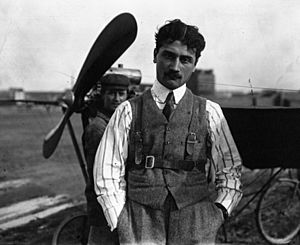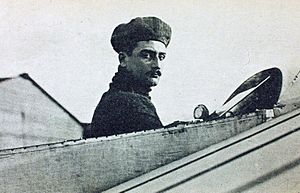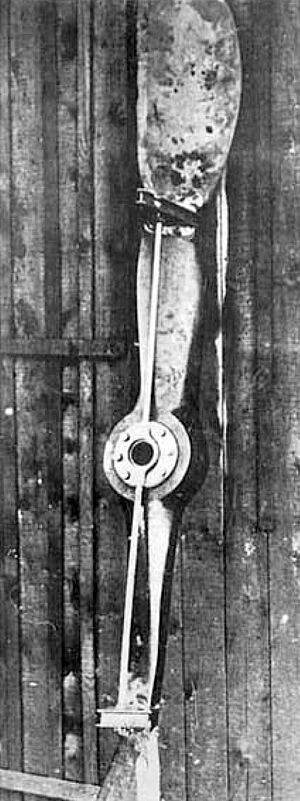Roland Garros (aviator) facts for kids
Quick facts for kids
Roland Garros
|
|
|---|---|

Garros in front of a Demoiselle aircraft in 1910
|
|
| Birth name | Eugène Adrien Roland Georges Garros |
| Born | 6 October 1888 Saint-Denis, Réunion, France |
| Died | 5 October 1918 (aged 29) Vouziers, Ardennes, France |
| Buried |
Vouziers, France
|
| Allegiance | France |
| Awards | Chevalier de la Légion d'honneur (1913) Officier de la Légion d'honneur (1918) |
Roland Garros (born Eugène Adrien Roland Georges Garros; 6 October 1888 – 5 October 1918) was a brave French aviation pioneer and fighter pilot. He started flying in 1909 and achieved many amazing feats. Later, he joined the French army and became one of the first fighter pilots during World War I.
Today, the famous Roland Garros tennis stadium in Paris is named after him. The well-known French Open tennis tournament, held at this stadium, also carries his name.
Contents
Early Life and Interests
Roland Garros was born in Saint-Denis, Réunion, an island that is part of France. He went to school in Paris.
When he was 12, he got sick with pneumonia. To help him recover, he was sent to Cannes. There, he started cycling to get stronger. He even won a championship in cycling between schools! He also loved playing football, rugby, and tennis.
When he was 21, Garros opened a car dealership in Paris. He was good friends with Ettore Bugatti, a famous car designer. In 1913, Garros became the first person to own a special Bugatti car. This car was later called Black Bess and can still be seen in a museum today.
Becoming an Aviator
In the summer of 1909, Roland Garros saw a big airshow called the Grande Semaine d'Aviation de la Champagne. After watching the planes fly, he knew he wanted to become a pilot.
He began his flying career in 1909 with a small plane called a Santos-Dumont Demoiselle. This plane was very light and only flew well with a small pilot. In July 1910, he earned his pilot's license.
In 1911, Garros started flying Blériot XI planes. He entered many air races across Europe. He even came in second place in a race from Paris to London and back.
Setting Flight Records
Roland Garros was also known for setting altitude records. On 4 September 1911, he flew to a height of 3,950 meters (about 12,960 feet). The next year, on 6 September 1912, he broke his own record. He flew even higher, reaching 5,610 meters (about 18,400 feet)!
In 1913, he flew faster Morane-Saulnier planes. On 23 September, he became very famous for making the first non-stop flight across the Mediterranean Sea. He flew from France to Tunisia, a journey that took almost eight hours. He even fixed his engine twice during the flight! The next year, when World War I began, Garros joined the French army.
The First Air Battle Story
In August 1914, some news reports said that Roland Garros was part of the "first air battle in world history." They claimed he crashed his plane into a German airship called a Zeppelin, destroying it and dying himself. However, these stories were quickly proven false. Garros was alive and well in Paris. Later, it was confirmed that the first real victory against a Zeppelin happened much later, in June 1915.
Developing a New Weapon
Early in World War I, pilots faced a big problem. They wanted to shoot machine guns forward from their planes, but the bullets would hit the propeller! Many people tried to solve this. Roland Garros, who flew reconnaissance missions, tried to shoot down German planes with a hand-held gun, but it was too hard to aim.
Garros worked with his mechanic, Jules Hue. They came up with a clever idea. They put metal wedges on the propeller blades. These wedges would deflect (bounce off) any bullets that might hit the propeller.
With this new invention on his plane, Garros achieved something amazing. On 1 April 1915, he shot down an enemy aircraft by firing through his propeller. He then shot down two more German planes on 15 and 18 April 1915. The Aero Club of America later gave him a medal for this invention.
Capture and its Impact
On 18 April 1915, Garros's plane was hit by enemy fire from the ground. He had to land in German territory. He tried to destroy his plane, but he couldn't completely. The Germans captured him, and they found his special gun and the armored propeller.
This was a big deal. A German aircraft company, Fokker, then used Garros's idea to create an even better system. Their system, called an "interrupter gear," stopped the gun from firing when the propeller was in the way. This new technology gave German planes a huge advantage. They shot down many Allied planes, a period known as the Fokker Scourge.
Escape from Prison
Roland Garros was a prisoner of war for almost three years. He was held in different German camps. But on 14 February 1918, he managed to escape with another pilot, Anselme Marchal. They traveled through the Netherlands and made it to London. From there, Garros returned to France and rejoined the army.
He went back to flying and claimed two more victories on 2 October 1918.
His Final Flight
Just one day before his 30th birthday, on 5 October 1918, Roland Garros was shot down and killed. This happened near Vouziers, France, only a month before the end of World War I. He was likely shot down by a German pilot named Hermann Habich.
His Lasting Legacy
Roland Garros is sometimes called the world's first fighter ace. However, to be an "ace," a pilot needed five or more victories, and Garros had four. The first official ace was another French pilot, Adolphe Pégoud, who had six victories.
Even so, Roland Garros is remembered in many ways:
- The famous Stade Roland Garros tennis center in Paris is named after him. This is where the French Open tennis tournament, one of the four biggest tennis events in the world, is held every year.
- The international airport on his home island of Réunion is called the Roland Garros Airport.
- There is a monument to Garros in Bizerte, Tunisia, where he landed after his famous flight across the Mediterranean Sea.
- The town of Houlgate in Normandy named their promenade after him because he broke an altitude record there.
- The French car company Peugeot has made special "Roland Garros" limited edition cars. These cars have unique paint and leather interiors. They were created to celebrate the tennis tournament named after him.
See also
 In Spanish: Roland Garros para niños
In Spanish: Roland Garros para niños
- History of the Armée de l'Air (1909–1942)



